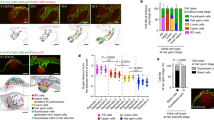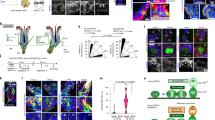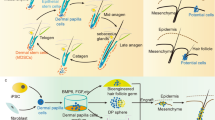Abstract
It is important to know how different organs ‘manage’ their stem cells. Both hair and feather follicles show robust regenerative powers that episodically renew the epithelial organ. However, the evolution of feathers (from reptiles to birds) and hairs (from reptiles to mammals) are independent events and their follicular structures result from convergent evolution. Because feathers do not have the anatomical equivalent of a hair follicle bulge, we are interested in determining where their stem cells are localized. By applying long-term label retention1, transplantation2 and DiI tracing to map stem cell activities, here we show that feather follicles contain slow-cycling long-term label-retaining cells (LRCs), transient amplifying cells and differentiating keratinocytes. Each population, located in anatomically distinct regions, undergoes dynamic homeostasis during the feather cycle. In the growing follicle, LRCs are enriched in a ‘collar bulge’ niche. In the moulting follicle, LRCs shift to populate a papillar ectoderm niche near the dermal papilla. On transplantation, LRCs show multipotentiality. In a three-dimensional view, LRCs are configured as a ring that is horizontally placed in radially symmetric feathers but tilted in bilaterally symmetric feathers. The changing topology of stem cell activities may contribute to the construction of complex feather forms.
This is a preview of subscription content, access via your institution
Access options
Subscribe to this journal
Receive 51 print issues and online access
$199.00 per year
only $3.90 per issue
Buy this article
- Purchase on Springer Link
- Instant access to full article PDF
Prices may be subject to local taxes which are calculated during checkout



Similar content being viewed by others
References
Morris, R. J. et al. Capturing and profiling adult hair follicle stem cells. Nature Biotechnol. 22, 411–417 (2004)
Oshima, H., Rochat, A., Kedzia, C., Kobayashi, K. & Barrandon, Y. Morphogenesis and renewal of hair follicles from adult multipotent stem cells. Cell 104, 233–245 (2001)
Tumbar, T. et al. Defining the epithelial stem cell niche in skin. Science 303, 359–363 (2004)
Lillie, F. R. & Wang, H. Physiology of development of the feather. V. Experimental morphogenesis. Physiol. Zool. 14, 103–133 (1941)
Lillie, F. R. & Wang, H. Physiology of development of the feather. VII. An experimental study of induction. Physiol. Zool. 17, 1–32 (1944)
Lucas, A. M. & Stettenheim, P. R. (eds) Avian Anatomy: Integument. Agriculture Handbook 362: Agricultural Research Services (US Dept. Agriculture, Washington DC, 1972)
Wang, H. The morphogenetic function of the epidermal and dermal components of the papilla in feather regeneration. Physiol. Zool. 16, 325–350 (1943)
Cohen, J. & Espinasse, P. G. On the normal and abnormal development of the feather. J. Embryol. Exp. Morphol. 9, 223–251 (1961)
Potten, C. S., Owen, G. & Booth, D. Intestinal stem cells protect their genome by selective segregation of template DNA strands. J. Cell Sci. 115, 2381–2388 (2002)
Cotsarelis, G., Sun, T. T. & Lavker, R. M. Label-retaining cells reside in the bulge area of pilosebaceous unit: implications for follicular stem cells, hair cycle, and skin carcinogenesis. Cell 61, 1329–1337 (1990)
Bronner-Fraser, M. Manipulations of neural crest cells or their migratory pathways. Methods Cell Biol. 51, 61–79 (1996)
Dupin, E., Ziller, C. & Le Douarin, N. M. The avian embryo as a model in developmental studies: chimeras and in vitro clonal analysis. Curr. Top. Dev. Biol. 36, 1–35 (1998)
Yu, M. et al. Developmental biology of feather follicles. Int. J. Dev. Biol. 48, 181–191 (2004)
Ting-Berreth, S. A. & Chuong, C. M. Sonic hedgehog in feather morphogenesis: Induction of mesenchymal condensation and association with cell death. Dev. Dyn. 207, 157–170 (1996)
Harris, M. P., Fallon, J. F. & Prum, R. O. Shh–Bmp2 signalling module and the evolutionary origin and diversification of feathers. J. Exp. Zool. 294, 160–176 (2002)
Prum, R. O. & Williamson, S. Theory of the growth and evolution of feather shape. J. Exp. Zool. 291, 30–57 (2001)
Fiala, J. C. & Harris, K. M. PC-based alignment and reconstruction of serial sections. Microsc. Anal. 52, 5–7 (2002)
Chuong, C. M. & Edelman, G. M. Expression of cell-adhesion molecules in embryonic induction. I. Morphogenesis of nestling feathers. J. Cell Biol. 101, 1009–1026 (1985)
Chuong, C. M. & Edelman, G. M. Expression of cell-adhesion molecules in embryonic induction. II. Morphogenesis of adult feathers. J. Cell Biol. 101, 1027–1043 (1985)
Kopan, R. et al. Genetic mosaic analysis indicates that the bulb region of coat hair follicles contains a resident population of several active multipotent epithelial lineage progenitors. Dev. Biol. 242, 44–57 (2002)
Watt, F. M. & Hogan, B. L. Out of Eden: stem cells and their niches. Science 287, 1427–1430 (2000)
Fuchs, E., Tumbar, T. & Guasch, G. Socializing with the neighbors: stem cells and their niche. Cell 116, 769–778 (2004)
Koster, M. I., Huntzinger, K. A. & Roop, D. R. Epidermal differentiation: transgenic/knockout mouse models reveal genes involved in stem cell fate decisions and commitment to differentiation. J. Investig. Dermatol. Symp. Proc. 7, 41–45 (2002)
Prum, R. O. Development and evolutionary origin of feathers. J. Exp. Zool. 285, 291–306 (1999)
Yu, M., Wu, P., Widelitz, R. B. & Chuong, C. M. The morphogenesis of feathers. Nature 420, 308–312 (2002)
Chuong, C.-M. et al. Adaptation to the sky: defining the feather with integument fossils from mesozoic China and experimental evidence from molecular laboratories. J. Exp. Zool. 298, 42–56 (2003)
Jiang, T.-X., Jung, H. S., Widelitz, R. B. & Chuong, C.-M. Self organization of periodic patterns by dissociated feather mesenchymal cells and the regulation of size, number and spacing of primordia. Development 126, 4997–5009 (1999)
Chodankar, R. et al. Shift of localized growth zones contributes to skin appendage morphogenesis: role of the Wnt/β-catenin pathway. J. Invest. Dermatol. 120, 20–26 (2003)
Wu, P., Jiang, T.-X., Suksaweang, S., Wideltz, R. B. & Chuong, C. M. Molecular shaping of the beak. Science 305, 1465–1466 (2004)
Acknowledgements
We thank G. Cotsarelis and R. Prum for helpful input; and all members of the Chuong laboratory for discussion. This work is supported by grants from the National Institute of Arthritis and Musculoskeletal and Skin Diseases (to C.M.C) and from the National Cancer Institute (to R.B.W.).
Author information
Authors and Affiliations
Corresponding author
Ethics declarations
Competing interests
Reprints and permissions information is available at npg.nature.com/reprintsandpermissions. The authors declare no competing financial interests.
Supplementary information
Supplementary Figure 1
Follicle structure and cell labelling. (JPG 316 kb)
Supplementary Figure 2
Transplantation to test multipotentiality. (JPG 329 kb)
Supplementary Figure 3
Pulse labelling and DiI tracing to follow cell lineages. (JPG 581 kb)
Supplementary Figure 4.
LRC and TA cells in molting stage follicles. (JPG 330 kb)
Supplementary Figure Legends
Full text to accompany the above Supplementary Figures. (DOC 27 kb)
Rights and permissions
About this article
Cite this article
Yue, Z., Jiang, TX., Widelitz, R. et al. Mapping stem cell activities in the feather follicle. Nature 438, 1026–1029 (2005). https://doi.org/10.1038/nature04222
Received:
Accepted:
Published:
Issue Date:
DOI: https://doi.org/10.1038/nature04222
This article is cited by
-
3D skin models in domestic animals
Veterinary Research (2021)
-
Comprehensive molecular and cellular studies suggest avian scutate scales are secondarily derived from feathers, and more distant from reptilian scales
Scientific Reports (2018)
-
Transmission electron microscopic and immunohistochemical observations of resting follicles of feathers in chicken show massive cell degeneration
Anatomical Science International (2018)
-
Diverse feather shape evolution enabled by coupling anisotropic signalling modules with self-organizing branching programme
Nature Communications (2017)
-
Quiescent adult stem cells in murine teeth are regulated by Shh signaling
Cell and Tissue Research (2017)
Comments
By submitting a comment you agree to abide by our Terms and Community Guidelines. If you find something abusive or that does not comply with our terms or guidelines please flag it as inappropriate.



